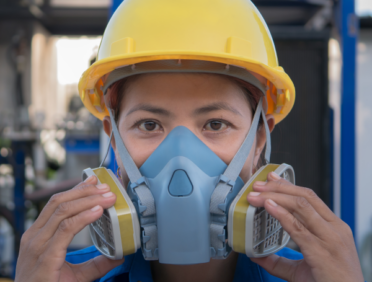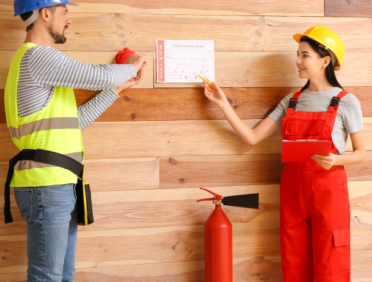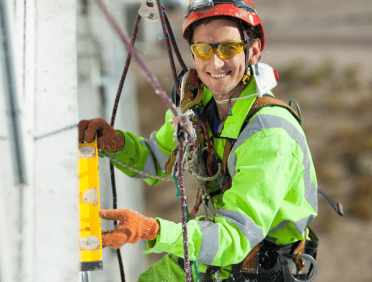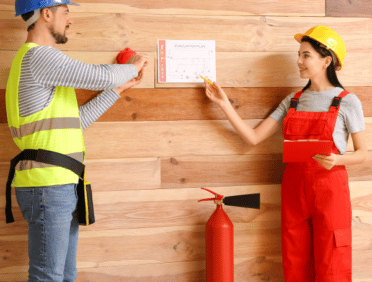Fire safety is a core part of being a responsible business owner. You need to make sure that you are safeguarding your staff and the general public with a suitable fire safety policy.
Understandably, new business owners may struggle to implement fire safety in the workplace properly, especially if they have had limited experience with it. For that reason, this guide intends to provide clear instructions on what to do to make sure that fire safety is taken care of within the work environment. Without further ado, let’s get started.
What is Fire Safety in the Workplace?
Fire safety is understood to be a set of practices which have been designed for reducing the damage and destruction caused by a fire. Fire safety practices can include things like preventing the ignition of fire, as well as taking measures to limit the spread of fire once it starts.
In addition to being the policies that are designed by business owners, the fire safety measures include things that were taken into consideration during building construction. All fire safety measures should be taught to staff members in the event of a fire.
As a discipline and a set of rules, fire safety is all about making sure that people are kept safe from harm and that the correct policies and procedures are in place. When it comes to getting the best results, you need to make sure that you have the best support measures in place to keep your building and its workers safe from harm. You must comply with all legislation. As a business owner, you will have legal responsibility for the implementation of a fire safety policy in accordance with all rules and regulations.
The Regulatory Reform (Fire Safety) Order 2005
If you manage, own, or operate a business, then you have to comply with fire safety laws as laid out in these guidelines.
The order will apply to almost every building, structure and place in the UK. The only buildings that are typically exempt from these rules are individual private houses. However, the rules do apply to large blocks of flats or other shared dwellings.
As a business owner, your responsibilities under this act are that your premises meet the required expectations for fire safety and that your staff are provided with suitable fire safety training.
The order came into force in October 2006 and is designed to offer a minimum fire safety standard for any and all non-domestic properties and premises (with a few obvious exceptions).
If the building is a workplace, then the act designates the employer as the responsible party for carrying out all requirements. If another person has control of the business to some extent, then they may also have certain duties under the order which need to be followed.
If the building is not a workplace, then any individual can be designated as the responsible party for overseeing all of the fire safety requirements. These individuals, or persons acting on their behalf, are obligated to carry out certain fire safety duties, which help to ensure that the general fire precautions in place are satisfactory and manage to conduct a proper fire risk assessment at the same time.
In the event that more than five people are employed by the company, it is necessary to document and record any fire safety risk assessments or other exercises carried out in accordance with fire safety.
It is important to note that this order supersedes and replaces any and all existing fire safety legislation, as well as any fire certificates which have been issued under the fire precautions act of 1971. Any certificates from this previous act will no longer be applicable.
However, if a business already had a fire certificate issued to them as part of their compliance with an existing part of the rules and regulations, then so long as they have not made any major material alterations to the property and all of the physical fire safety rules and regulations are being adhered to, it is highly unlikely that a business will need to make any substantial changes or alterations to their existing fire protection arrangements to achieve compliance with the new rules.
With that being said, you are still responsible for carrying out a proper fire risk assessment and making sure that it remains up to date to keep the precautions in your premise property adequate and current. In the event that you carried out a proper fire risk assessment in accordance with the Fire Precautions (Workplace) Regulations 1997/1999, and if this assessment has been recorded and reviewed on a regular basis, then the only thing that you will need to do to achieve compliance is to update the assessment within the modern context of the existing order.
Finally, as a business, you may find that you are required to seek the provision of a licence or registration in accordance with the Licencing Act 2003. If this is the case, then the local fire authority may wish to think about helping you review your risk assessment as part of the approval process to help guarantee compliance. It is also worth noting that any fire safety conditions within the terms of your licence should not be set by the licensing authority in situations where the order applies to you.
General Fire Safety Hazards
General fire safety hazards make reference to the fact that there are three things that a fire needs to start. It needs a source of ignition, a source of fuel, and oxygen.
A source of ignition can include something like a heater, lighting, naked flames, smokers, and anything which can get very hot or create sparks. Fuel sources can include anything naturally flammable, like wood or paper, rubber and foam, or loose packing materials. A source of action would naturally be the air all around us. All three of these sources need to be present for a fire to start.
What Do I Have to Do as an Employer?
As an employer, your responsibilities will be to make sure that you take proper steps to guarantee that your team is protected when it comes to fire safety. You will also have the responsibility of providing your workers with adequate training to guarantee that they understand how fire safety works and that they can take any measures necessary to protect themselves and others from the risk of fire. As an employer, this is your responsibility and legal requirement to fulfil fire safety policies.
What Do I Have to Do as an Employee?
As an employee working for the business, you have a responsibility to attend any training provided by your employer regarding fire safety. This may include completing a qualification or simply attending training seminars, but you have a responsibility either way. You also have a responsibility within your workplace to act in such a way that is responsible and practical, making sure that you take notice of any business practices which are going to violate health and safety when it comes to fire. If you do spot any discrepancies, report them to your superior.
Who’s Responsible?
When it comes to the responsibilities of fire safety, they will fall to the business owner or manager. If you are the leader of the company, then you have a responsibility to create proper fire safety protocols, conduct a fire safety risk assessment, and generally make sure that your workers are responsible and trained.
However, as the highest-ranking member of the team, you are responsible for these things unless you nominate and fully train somebody to conduct these matters in your stead. If this is the case, then that individual must receive full training on how to enforce and teach fire safety protocol.
The fire safety risk assessment is something which all employers (or staff members responsible) need to carry out as part of a robust policy for safety. This is a core part of your responsibilities when it comes to fire safety and general risk assessments.
The risk assessment will detail things like what kinds of issues are present, how you’ll deal with those issues, and what this means for the business as a whole. You’ll be expected to document this risk assessment if you have more than five workers. However, document it in any scenario.
Fire Safety Equipment
There are many components to a robust fire safety policy, and the equipment you use is one of them.
This equipment can take many forms – from the correct extinguishers to deal with a given fire through to the emergency doors and exits that the building has in the event of a fire. In all cases, you’ll be expected to have all of the right equipment, and it will be considered a health and safety violation if you don’t actively have the right items available, so part of your risk assessment will be identifying what items are needed.
Electrical Safety
Electrical safety is a core component of a successful fire risk assessment policy and general fire safety. Electrical components can be one of the leading causes of fire, so it is important to evaluate the risks that can come from them in the workplace. If you work with a lot of electrical equipment, then it is absolutely vital that they are factored into any type of assessment that you do to identify hazards. You should also have the right fire safety equipment for dealing with electrical-based fires because regular equipment isn’t always suitable for them.
If there is a kitchen environment for your staff, then it also needs to be subject to a fire risk assessment. There are many electrical components and plumbing inside the kitchen that must be taken into consideration. The event of a flood or electrical fault with one of the appliances could easily result in a fire. You need to examine all of the risks involved in a kitchen environment and make the right changes necessary. This is a key part of any sensible policy that deals with fire safety.
Naked Flames
Naked flames are often a core part of many businesses, but they do represent a serious fire safety concern, as one might expect. Therefore, any fire risk assessment which is done to evaluate the safety of the workplace will need to take the naked flames into consideration. Are they kept far enough away from flammable objects? Is there fire suppression equipment on hand in case of an emergency?
All of these considerations are important and will make a difference when it comes to both fire safety and general health and safety codes. In many cases, they should form the backbone of your existing policy.
Keep Your Workplace Clean and Tidy
Naturally, a core part of fire safety in the workplace is often about keeping your workspace clean and tidy. Leaving flammable materials or chemicals lying around where they could be exposed to an open flame is an accident waiting to happen.
Therefore, any fire safety policies that you put in place need to take into consideration basic hygiene and cleaning standards. It may not seem like an important concern on the surface, but when you get down to it, it is very important to keep in mind all of these things. You’ll want to be sensible with fire safety.
Make a Fire Escape Plan
As part of your fire safety guidance, you should make sure that you have a fire escape plan implemented. It’s important to acknowledge that this kind of thing makes all the difference in a crisis situation. There needs to be a clearly marked and identified system in place to staff the information they need to evacuate quickly and safely during a fire-related emergency. As the business owner, it will be up to you to design and implement this escape plan as part of the basic fire safety policies and procedures you have a responsibility to develop.
Appoint Fire Wardens
Fire wardens are a useful resource for fire safety. As designated members of your team, they will help you to implement and create the necessary fire safety arrangements. Once you’ve identified what needs to happen, a fire warden can be used to go and make sure the necessary changes are made to protect your team. Make sure that you appoint a fire warden who is suitable for the role and that you consider their training because they will need a specialist level of training to make sure that they can carry out their duties.
If you are the person who discovers that a fire has broken out, then you need to do the following things. First, look for the fire suppression equipment in the area, and if you can contain the blaze, do so. However, if it is already out of control, sound the fire alarm, head to the nearest group of employees and begin evacuating them according to the fire escape plan. If the emergency services are not notified, then contact them immediately to make sure that they arrive to help put the fire out.
Penalties and Enforcement
As part of fire safety rules and regulations, you are responsible for your fire safety policies under The Regulatory Reform (Fire Safety) Order 2005. If you fail to comply with these regulations, then you are in breach of your duties as a business owner. You will therefore be subject to unlimited fines and potentially two years in prison. Rest assured that whatever inconvenience you may encounter doing these assessments is dwarfed by the massive financial damage that can be incurred by your negligence. These charges can and have bankrupted businesses.
When it comes to your staff, you have a responsibility to conduct fire safety training to make sure that they are equipped to respond to emergency situations involving fires. For this reason, you will be expected to provide full and comprehensive training for all staff. Learn Q is more than happy to assist in these requirements. We provide full and comprehensive training to a range of people and groups, making sure that they are equipped to deal with fires in a safe manner. You have a responsibility to train your staff properly by law, so we would be more than happy to assist you in meeting your obligations.
To download a .pdf of this blog, please click here












